Eminent author Emilie Buchwald claims that “Children are made readers on the laps of their parents.” Children become lifelong readers if they are introduced to books at a young age. Adults should strive to provide children with as many books as possible.
This task is fairly easy since literature for the very young is rich and varied and comes in many genres and formats. There are board books, concept books, and picture books. Young children may enjoy reading fiction or nonfiction, cumulative stories, rhyming books, and wordless picture books. They can also enjoy tales that are written exclusively for them.
Members of the International Reading Association's Children's Literature and Reading Special Interest Group share some of their favorites for the very youngest readers in this week’s column. We are certain that some of these books can help readers find book joy on their own or with the help of a reading buddy.
Books for Young Readers
Bloom, C. P. (2014). The monkey goes bananas. Illus. by Peter Raymumdo. New York, NY: Abrams Books for Young Readers.
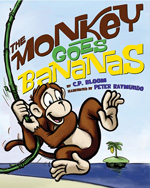 This book contains just three words: monkey, shark, and banana. A determined monkey spies a banana tree with a bunch of tempting bananas just across the water. He wants to reach the bananas, but the waters beneath them are patrolled by a notorious shark. Will the monkey succeed in his task? Maybe he will, maybe he will not. But for sure, this book with its humor, ingenuity, and creativity will succeed in making readers laugh. This book is a great choice for a class sharing on a day when students cannot go out to play or the mood of the classroom needs to be lifted.
This book contains just three words: monkey, shark, and banana. A determined monkey spies a banana tree with a bunch of tempting bananas just across the water. He wants to reach the bananas, but the waters beneath them are patrolled by a notorious shark. Will the monkey succeed in his task? Maybe he will, maybe he will not. But for sure, this book with its humor, ingenuity, and creativity will succeed in making readers laugh. This book is a great choice for a class sharing on a day when students cannot go out to play or the mood of the classroom needs to be lifted.
-Rani Iyer, Washington State University Pullman
Colins, Luke. (2014). George Washington Carver. North Mankato, MN: Capstone Press.
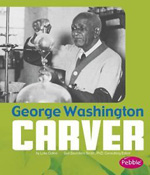 Peanuts are our good friends. Not only are they are in our sandwiches and snacks, but they are in the ink of our favorite pen and in soap for our laundry. Thanks to George Washington Carver, a famous African-American scientist best known for his peanut research, peanuts now have multiple uses. Born on a farm in Missouri as a slave, George attended school at the age of 11. After finishing college, he became a teacher of plants and farming at Tuskegee Institute in Alabama, working with farmers to grow more crops and make soil healthy again. With a glossary list, recommended books and websites, and questions for critical thinking in the back of the book, this easy-to- read title provides an overview of the life of an influential scientist.
Peanuts are our good friends. Not only are they are in our sandwiches and snacks, but they are in the ink of our favorite pen and in soap for our laundry. Thanks to George Washington Carver, a famous African-American scientist best known for his peanut research, peanuts now have multiple uses. Born on a farm in Missouri as a slave, George attended school at the age of 11. After finishing college, he became a teacher of plants and farming at Tuskegee Institute in Alabama, working with farmers to grow more crops and make soil healthy again. With a glossary list, recommended books and websites, and questions for critical thinking in the back of the book, this easy-to- read title provides an overview of the life of an influential scientist.
-Ying-Hsuan Lee, Washington State University Pullman
Dahl, Michael. (2014). Little Monkey calms down. Illus. by Oriol Vidal. North Mankato, MN: Picture Window Books.
 The board book tells readers what to do when they feel sad, mad, or angry. Crying is okay, but tantrums are not. The book advises the following actions:
The board book tells readers what to do when they feel sad, mad, or angry. Crying is okay, but tantrums are not. The book advises the following actions:
Take a deep breath.
Huddle with your favorite thing.
Sing a quiet song.
Be still.
Relax.
Now that the storm has passed, it is time to jump and have fun!
This book is useful for kids of all ages. Teachers, parents, caregivers, and psychologists will find it helpful as they discuss feelings with children.
-Rani Iyer, Washington State University, Pullman
Degman, Lori. (2014). Cock-a-doodle oops! Illus. by Deborah Zemke. Berkeley, CA: Creston Books.
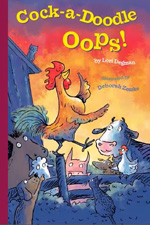 When Farmer McPeppers is fast asleep, the rooster decides to take a vacation by the seaside., The animals decide that won’t be a problem. On Monday, the pig tries to awaken them, but his cries do not sound the same as the rooster. Nor are the awakening calls on Tuesday, Wednesday, Thursday, or Friday effective. When the rooster comes back, he complains that his throat hurts. The animals are worried that Farmer McPeppers would not wake up soon.
When Farmer McPeppers is fast asleep, the rooster decides to take a vacation by the seaside., The animals decide that won’t be a problem. On Monday, the pig tries to awaken them, but his cries do not sound the same as the rooster. Nor are the awakening calls on Tuesday, Wednesday, Thursday, or Friday effective. When the rooster comes back, he complains that his throat hurts. The animals are worried that Farmer McPeppers would not wake up soon.
With the help of his friends, the rooster gets his voice back. As soon as Farmer McPeppers wakes up, he decides the voice of the rooster does not sound too good and he needs a break for a week. The delightful script would be great for a class play, reader’s theatre, and classroom read aloud with the teacher inviting students to play the roles of various animals.
-Rani Iyer, Washington State University Pullman
Hancocks, Helen. (2014). Penguin in peril. Somerville, MA: Templar Books.
 After throwing out the last fish bone, three hungry cats are officially out of food. Using three gold coins, they go out in search of food. Instead of buying groceries, the cats spend the three coins to watch a movie, “The Fishy Feast.” The movie gives the cats an idea—if they can find a penguin, they will have endless fish as food. Immediately, they draw up a plan and steal a penguin from the zoo. When the penguin senses his perilous situation, he escapes.
After throwing out the last fish bone, three hungry cats are officially out of food. Using three gold coins, they go out in search of food. Instead of buying groceries, the cats spend the three coins to watch a movie, “The Fishy Feast.” The movie gives the cats an idea—if they can find a penguin, they will have endless fish as food. Immediately, they draw up a plan and steal a penguin from the zoo. When the penguin senses his perilous situation, he escapes.
Hiding among nuns, gentlemen in black suits, and restaurant waiters, the penguin finally returns to the zoo safely and enjoys his own fishy feast, while the cats end up behind bars and will “get gruel for life” (unpaged). This is a story with simple storyline, but amusing illustrations that contain visual humor. Readers should be sure to look at both the front and back endpapers to find some clues about what happens to the cats in this story.
-Ying-Hsuan Lee, Washington State University Pullman
Kantorovitz, Sylvie. (2014). The very tiny baby. Watertown, MA: Charlesbridge.
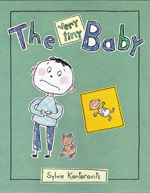 Jacob is not sure if he and his stuffed bear, Bob, are happy about the baby in Mommy’s belly. He listens to Mommy’s belly to feel the growing baby, which is both weird and exciting, but he is afraid of losing the attention of the adults in his life. As Daddy, Mommy, and Grandma all worry about the baby, since it is born prematurely, Jacob is jealous. Not until the doctor confirms that the baby is safe and ready to go home does Jacob realize that being a special big brother is important.
Jacob is not sure if he and his stuffed bear, Bob, are happy about the baby in Mommy’s belly. He listens to Mommy’s belly to feel the growing baby, which is both weird and exciting, but he is afraid of losing the attention of the adults in his life. As Daddy, Mommy, and Grandma all worry about the baby, since it is born prematurely, Jacob is jealous. Not until the doctor confirms that the baby is safe and ready to go home does Jacob realize that being a special big brother is important.
Drawing on personal experience, Sylvie Kantorovitz describes an experience familiar to many older brothers or sisters. Emotions of happiness, jealousy, anxiety, and anger have all contributed to the ambivalent feeling of welcoming a new family member. Parents and children can read this story together to help children understand the importance of family bonds.
-Ying-Hsuan Lee, Washington State University Pullman
McDonald, Megan. (2014). Judy Moody and friends: Rocky Zang in The Amazing Mr. Magic. Illus. by Erwin Madrid. Somerville, MA: Candlewick Press.
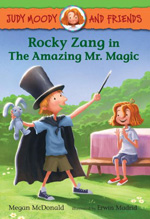 With a magician’s outfit and accessories, Rocky, a novice magician, wants to show everyone that he can perform magic. His first magic trick, with Judy Moody, his good friend, ends up being a bust. But he doesn’t give up. Convinced by Judy, he decides to hire her as his spectacular assistant for a Back Yard Magic Show. However, no one except Judy’s brother, Stink comes to the show. What is worse, Rocky and Judy do not cooperate well which makes this second magic show a flop too. Though frustrated, Rocky is able to present a marvelous magic show that earns Judy’s admiration.
With a magician’s outfit and accessories, Rocky, a novice magician, wants to show everyone that he can perform magic. His first magic trick, with Judy Moody, his good friend, ends up being a bust. But he doesn’t give up. Convinced by Judy, he decides to hire her as his spectacular assistant for a Back Yard Magic Show. However, no one except Judy’s brother, Stink comes to the show. What is worse, Rocky and Judy do not cooperate well which makes this second magic show a flop too. Though frustrated, Rocky is able to present a marvelous magic show that earns Judy’s admiration.
Filled with humor and friendship, this easy reader will make young readers laugh when they see how Rocky and Judy fail in many tricks, but continue to have a positive attitude toward the unexpected outcomes. Young children who are fascinated with magic are likely to wave their own magic wands after reading this book.
-Ying-Hsuan Lee, Washington State University Pullman
Murphy, Mary. (2014). Say hello like this! Somerville, MA: Candlewick Press.
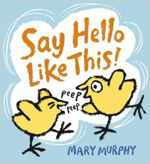 Different animals say hello in different ways. Dogs wow-wow; cats purr-meow; frogs croak-croak; chickens cluck-cluck; beetles tap-tap; donkeys hee-haw. How about you, readers?
Different animals say hello in different ways. Dogs wow-wow; cats purr-meow; frogs croak-croak; chickens cluck-cluck; beetles tap-tap; donkeys hee-haw. How about you, readers?
This book is a celebration of greeting in different ways. The text has repetitive patterns with the use of onomatopoeia and alliteration, which make it enjoyable when being read aloud. The illustrations provide a happy atmosphere supported by page design that enables readers to see dogs licking each other, frogs jumping croakily, chickens dancing uniquely, and donkeys braying loudly as pages are turned. Anyone who reads this simple but attractive book will laugh in delight.
-Ying-Hsuan Lee, Washington State University Pullman
Rippin, Sally. (2014). Bille B. Brown: The secret message. Tulsa, OK: Kane Miller.
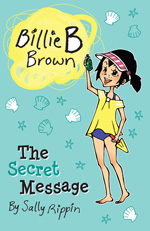 Every summer, Billie goes to the beach. She loves it! Her parents sit under the umbrella, reading; sometimes they nap. Not fun. Billie is here to have fun. She wants to build a sand castle. Perhaps it would be big. Perhaps it would be as big and fancy as the one the two girls across the beach were creating. As Billie digs, she finds a dark, tiny bottle. The two girls come over to meet Billie, and they decide the bottle could have a secret message. However, when Billie performs a handstand, the bottle drops and breaks, and even worse, Billie falls over the beautiful sandcastle. Can the girls be friends again? What can Billie do to save the day? This lighthearted tale is perfect for a classroom read aloud.
Every summer, Billie goes to the beach. She loves it! Her parents sit under the umbrella, reading; sometimes they nap. Not fun. Billie is here to have fun. She wants to build a sand castle. Perhaps it would be big. Perhaps it would be as big and fancy as the one the two girls across the beach were creating. As Billie digs, she finds a dark, tiny bottle. The two girls come over to meet Billie, and they decide the bottle could have a secret message. However, when Billie performs a handstand, the bottle drops and breaks, and even worse, Billie falls over the beautiful sandcastle. Can the girls be friends again? What can Billie do to save the day? This lighthearted tale is perfect for a classroom read aloud.
-Rani Iyer, Washington State University Pullman
Sohn, Tania. (2014). Socks! Tulsa, OK: Kane Miller.
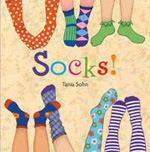 Most children wear socks, at least in the winter and fall. This delightful book highlights the different kinds of socks. The child in the book uses different socks for different purposes, including playing games. Daddy’s socks, with a little imagination, become the trunk of an elephant. Ankle socks come alive to help the child fly. And what about the surprise Grandma sends?
Most children wear socks, at least in the winter and fall. This delightful book highlights the different kinds of socks. The child in the book uses different socks for different purposes, including playing games. Daddy’s socks, with a little imagination, become the trunk of an elephant. Ankle socks come alive to help the child fly. And what about the surprise Grandma sends?
This lovely book can be used as a perfect mentor text to start brainstorming ideas for young children to write or tell stories about their own collections of clothing.
-Rani Iyer, Washington State University Pullman
The CL/R SIG will host a special session called Children's Literature: The Perfect Teachable Moment on Saturday, May 10 at 3:00 p.m. at the International Reading Association 59th Annual Conference in New Orleans. The session includes keynote speaker Nancy Bo Flood (author of Warriors in the Crossfire) and a presentation of the 2014 Notable Books for a Global Society (NBGS). Visit http://www.iraconference.org to learn more about IRA 2014 or to register.
These reviews are submitted by members of the International Reading Association's Children's Literature and Reading Special Interest Group (CL/R SIG) and are published weekly on Reading Today Online.
The CL/R SIG is accepting submissions to the fall 2014 edition of their journal, The Dragon Lode, through April 15, 2014. There is an open theme, and they invite manuscripts that explore contemporary issues and questions, genre study, literary theory, and research related to children's literature and reading. Manuscripts should be no longer than 20 double-spaced, typed pages. Use APA (6th edition) formatting. Author's name, affiliation, mailing address, telephone and fax numbers, and e-mail address should be on a separate cover page. Photos and illustrations should be sent as a separate jpeg file. Any reference to the author that would enable the reviewer to know the author's identity should not appear in the manuscript. Submit all manuscripts to: Dr. Ruth McKoy Lowery, Co-editor.